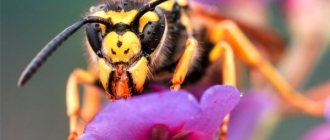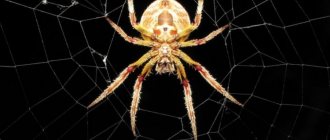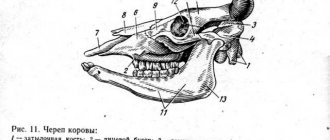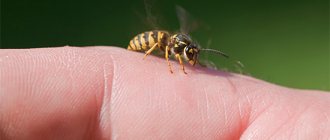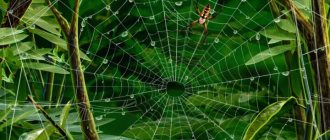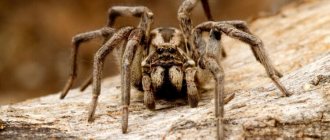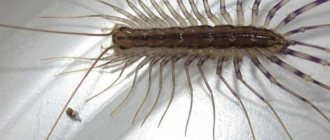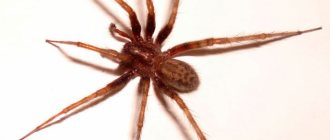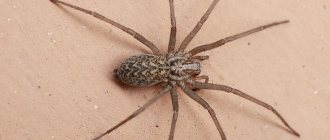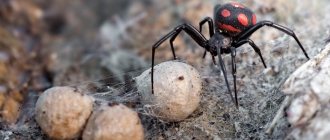Spiders are one of the oldest animals on Earth and can be found almost everywhere in the world today. It is difficult to be indifferent to these creatures: they frighten some, fascinate others.
These are amazing creatures of nature that still hide many mysteries.
Description of the spider
Spiders have lived on Earth for hundreds of millions of years. During this period, their appearance has remained virtually unchanged, and the modern spider has the same appearance as its distant ancestor who lived in the Mesozoic era.
These creatures are carnivorous; they obtain all the substances necessary for life by eating caught insects. The vast majority of species develop webs and hunt using webs woven from them.
Body structure
The body structure of spiders is somewhat similar to some insects. The cephalothorax and abdomen are connected by a thin tube - a stalk. There is a groove on the cephalothorax that separates the spider's head and thorax.
On the side of the head there are eyes and two pairs of limbs, transformed into organs of touch and nutrition, between which there is a mouth intended for sucking.
Arachnids have an exoskeleton. The spider's body is covered with chitin. On both sides of the chest there are 4 pairs of legs, each of which consists of 7 segments. This anatomy is typical of all spiders, regardless of species.
Blood circulation and breathing
Spiders have an open circulatory system. It consists of a two-chambered heart and blood vessels that open directly into the body cavity. Spider blood is blue, so it is colored by hemocyanin, an analogue of hemoglobin.
The respiratory organs of spiders are the pulmonary sacs and trachea. The first are thin lamellas, the second are thin tubes through which oxygen flows from the spiracles to the tissues of the internal organs.
central nervous system
The spider's nervous system is the brain, which consists of two nerve nodes and endings that diverge to the senses and internal organs.
The brain is located in the cephalothorax, occupying up to 30% of its volume.
The transmission of nerve impulses occurs very quickly, so arthropods demonstrate excellent reactions.
Sensory organs
The main organ with which spiders navigate in the surrounding space is their eyes. Depending on the species, there can be from 2 to 12. The spider’s vision depends on its habitat.
Thus, people living in dark caves are practically blind, and, for example, jumping spiders can see perfectly and even distinguish colors.
Small sensitive hairs on the paws of arthropods are responsible for touch, smell and hearing. Spiders don't have ears.
Movement
Spiders move along the surface with 4 pairs of legs. There are species that can move on water. They do this using special hairs on their legs that allow them to glide across the surface of the water.
Feeding spiders
All spiders are predators. They feed mainly on insects. Spiders can eat:
- flies;
- mosquitoes;
- beetles;
- butterflies;
- crickets;
- grasshoppers;
- locusts
Some spiders eat beetles, worms and snails. As a rule, the spider hunts using a web woven from it.
A web of thin but very strong and sticky threads is usually stretched vertically (some species place it horizontally, others weave it in a funnel shape) between trees, plant stems and blades of grass.
When prey falls into a trap, the predator injects paralyzing poison into its body, as well as digestive juices that devour the prey from the inside. After waiting for some time, the spider sucks out the insect's insects.
Only growing young animals need regular nutrition. An adult spider can live without food for several days, weeks or even months.
Features of reproduction
Spiders reproduce sexually. In many species, after mating, the female eats the male, providing the nutrients needed to produce eggs.
The fertilized female lays eggs. Some species lie in the ground, but most build strong cocoons from spider webs.
Baby spiders are born fully formed. During the development process, they die several times until they turn into sexually mature adults.
Coloring
Spiders have only 3 pigments (yellow, red, blue), which determine the color of the body and limbs. Their combinations give arachnids various shades, the most common of which is brown.
The scales, found on the body of many species, can reflect or refract light, causing the spider to change color depending on the light.
Are spiders insects or not?
One of the most frequently asked questions about spiders is: “Are they insects or animals?” It’s worth starting with the fact that all insects belong to the animal kingdom. Spiders are also animals, but despite their small size and some similarities, they are not insects.
General signs
Both insects and spiders are arthropods. This explains the presence of similar signs in them, such as:
- external chitinous skeleton;
- compound compound eyes;
- the legs are located in pairs on both sides of the thoracic region.
In addition, both of them reproduce by laying eggs.
Main differences
Differences between spiders and insects:
- spiders are animals with eight legs, while insects have six;
- In insects, the movable head is connected to the chest; in spiders, it is connected to a monolithic cephalothorax;
- spiders weave webs;
- Spiders, unlike insects, do not have antennae;
- There is no process of metamorphosis in the development of spiders.
In addition, the process of eating in insects and spiders is radically different.
What order and class do spiders belong to?
Arachnids, like insects, belong to the phylum Arthropods, the most diverse and widespread group of living organisms.
Spiders belong to the class of arachnids, which also includes ticks and scorpions.
Of all arachnids, spiders are the most numerous order. All spiders are divided into 112 families and more than 4000 genera.
The science of arachnology deals with the classification and study of spiders.
Natural enemies
In nature, spiders have many enemies who are not averse to biting them. These include birds, as well as other vertebrates: amphibians and reptiles (for example, salamanders, geckos, iguanas), as well as mammals (for example, hedgehogs or bats). Some species of spiders, such as mimetids, feed exclusively on spiders of other species. Tropical insects and ants also do not miss the opportunity to prey on them.
Adults of some species of wasps do not eat spiders themselves, but instead turn them into a kind of food warehouse for their offspring.
They paralyze their victims and carry them to their nest, where they lay eggs inside their bodies. The hatched larvae lead a parasitic lifestyle, literally eating the spider from the inside.
Return to content
Distribution and habitats
Spiders can even live where other living things cannot. They are distributed on all continents and islands, with the exception of areas covered with ice all year round. The vast majority of spiders build burrows, nests and other shelters, but some species do not have a permanent habitat.
Species and subspecies
It is very difficult to answer the question of what spiders are, since representatives of this order are very numerous and diverse.
Currently, scientists know more than 42,000 species of spiders. All of them are predators; representatives of about 60 species occasionally eat plant food, and only one species feeds exclusively on plants.
According to the generally accepted classification, all spiders are divided into 3 suborders:
- Mesothelium;
- Opistotle Araneomorpha;
- Opistotle
Representatives of the mesotel suborder are considered the most primitive. They live mainly in holes in the ground, the entrance to which is closed with a kind of lid.
Spiders of the suborder Mygalomorphae or migalomorphae are large, with heavily pubescent bodies and legs. The vast majority live in regions with warm climates.
The suborder Araneomorpha is considered the most numerous. This includes arthropods that hunt with a web, do without it, as well as those who do not know how to weave a web at all.
Reproduction
Spiders are dioecious animals. Their genitals are located on the lower part of the abdomen. Males from there collect sperm into the bulbs at the ends of the pedipalps and transfer it to the female’s genital opening.
In most cases, sexual dimorphism of spiders is present. Males are usually much smaller than females, but are brighter in color. They are more interested in reproduction, while females often attack suitors before, after and during mating.
The courtship of some species of spiders is a separate form of art. For example, the tiny peacock spider has invented an entire dance that shows the female his intentions.
Place in nature
Spiders are an important and irreplaceable part of the ecosystem. They are of great importance and perform important functions:
- When feeding on a variety of insects, regulate their quantity;
- They themselves are food for many animals.
Among those who eat spiders:
- insects (mantises, blackbirds, scolopendras, wasps);
- spiders (representatives of some species feed on their own species);
- reptiles (snakes, lizards);
- amphibians (toads, frogs);
- small mammals (hedgehogs, rats, mice, noses).
And, of course, birds eat spiders, some of which rely on arachnids as their main food.
Ctenizidae.
In some areas of the United States, interesting spiders from the family Ctenizidae are found. They vary in size and reach a length of 2.5 cm; The color of the massive body is dark. These spiders dig holes in the ground and line their walls with cobwebs. A characteristic feature of such shelters is a tightly fitted door, which is very difficult to open when the spider is holding it from the inside. It has been established that in this case the animal can withstand a pulling force equal to almost a pound: for a person it is equivalent to 10 tons. From time to time, ctenisids leave their burrows to hunt. Their main enemy is a type of wasp that can open the door of their lair or attack spiders when they are outside.
Man and Spider
Spiders play a fairly significant role in people's lives:
- arthropods destroy many harmful insects, helping to preserve the yield of agricultural plants;
- in some countries, well-cooked spiders of some species are considered a delicacy;
- scientists are actively studying the properties of spider venom and exploring the possibilities of using it in medicine to treat various diseases, for example, Alzheimer's disease or erectile dysfunction;
- some species are very popular as exotic pets;
- physicists are studying the unique properties of the web and its role in the life of spiders and are trying to create a similar material.
In addition, the unusual appearance and abilities of arthropods have become the reason that spiders often become characters in works of art: comics, books, films.
But the danger of spiders to humans is greatly exaggerated. Indeed, the bite of some poisonous individuals can cause health problems, but very often the person himself provokes an attack. It is extremely rare for spiders to attack people for no reason.
Arachnophobia
Arachnophobia, or fear of spiders, is one of the most common and difficult to treat phobias in the world. People with this disease experience attacks of fear and sometimes panic at the sight of even the smallest and most harmless spider.
Moreover, not only a living person, but also his image can cause negative emotions. Attacks are often accompanied by weakness, dizziness, nausea and increased sweating. Particularly sensitive people faint.
Fun fact: Most patients have never experienced an arachnid attack, so their fears are unfounded.
What happens to your body if you are bitten by a tarantula?
Tarantulas, in truth, have a terrible reputation—literally. They're big, furry, and menacing-looking, which is why horror movie directors love them. Using a clever combination of arachnophobia and computer-generated special effects, they've been passing off spiders as monsters for decades. As a result, a myth about the special poisonousness and danger of tarantula spiders spread across the planet.
In fact, a tarantula bite is no more dangerous than a bee sting. Yes, it’s unpleasant: pain, redness, burning, a possible allergic reaction - all that, but no worse. And tarantulas that are kept as pets do not bite at all. In general, the reputation of these large furry creatures has suffered from their spectacular appearance, but this is not their fault at all.
***

